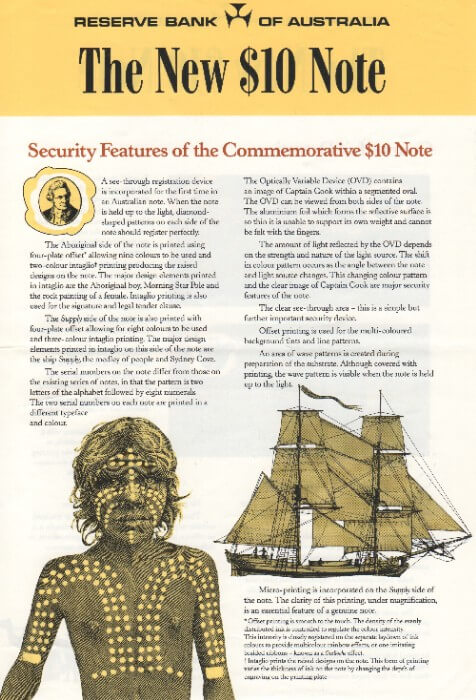Australia's 1988 Bicentennial $10 Note – An Elaborate Field Test
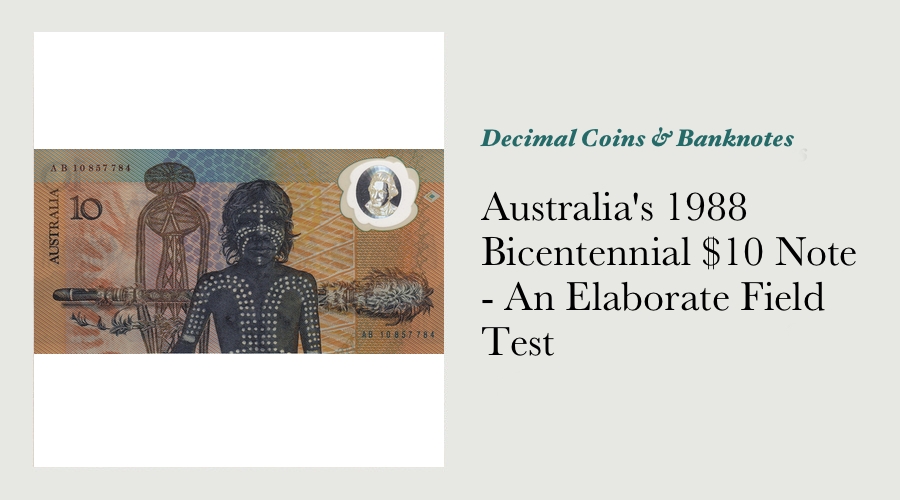
Commemoration of 200 Years of European Settlement
It's long been thought that the ten dollar note issued in 1988 by the Reserve Bank of Australia (RBA) simply honoured the 200th anniversary of European settlement in Australia. This momentous occasion celebrated our nation's achievements and cultural heritage, and undoubtedly deserved being marked by our first commemorative note.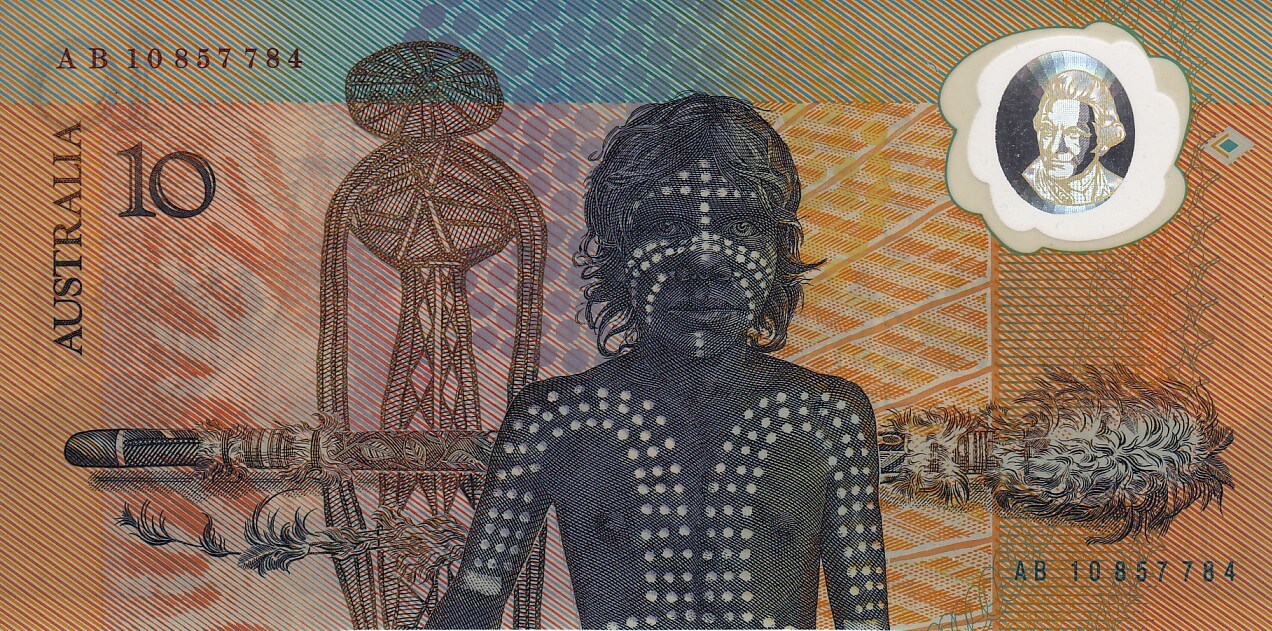
Several disclosures recently published in the international currency printing trade media however reveal that the Bicentennial note program was just as important to the RBA as a calculated field test of the innovative printing technology that had been developed by Note Printing Australia (NPA) and the Commonwealth Scientific and Industrial Research Organisation (CSIRO).
Much was riding on the $10 note circulating in a satisfactory manner – over $20 million had been sunk into research and production costs in this technology over two decades, with the intention that Australia would eventually convert it's entire circulating currency to the new “plastic fantastic” notes, after which the technology would then be exported the world over.
The Australian public was completely unaware that every interaction it had with these revolutionary notes was observed and studied, so it should be hardly surprising that the broader numismatic community has taken time to fully appreciate their true historical importance. No less than 11 distinct varieties have been identified, the rarest of them has a catalogue value of $38,000. (Refer to table at the end of this article for a complete list).
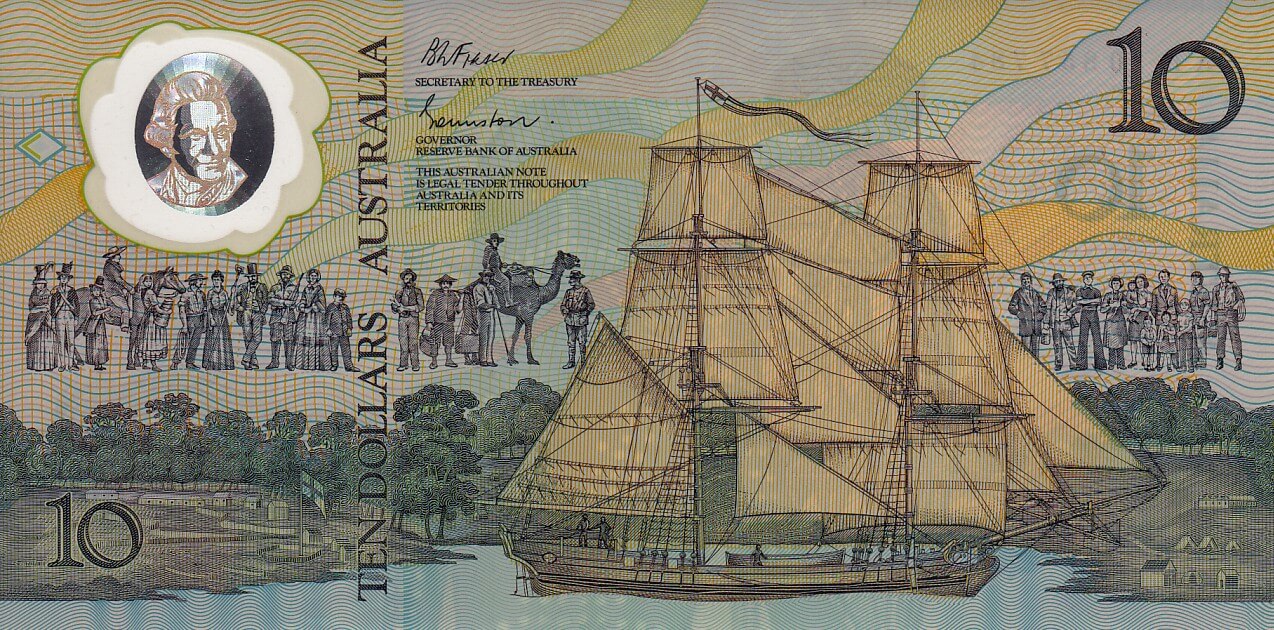
Seven nations other than Australia have also made a complete switch to polymer notes, while a further twenty eight countries now have at least some polymer notes in circulation. Polymer technology is so important to the world's circulating currency that the background to the issue of Australia's 1988 commemorative $10 note is regularly studied and discussed by bureaucrats and numismatists the world over.
This ongoing scholarly attention, coupled with demand from polymer note collectors right around the world will ensure that the rarer varieties of this note are certain to be in demand with collectors to come.
$20 Million Invested Over 22 Years
The background to the world's first circulating polymer banknote can be traced back to 1966, and the introduction of decimal currency to Australia's monetary system. On December 28th 1966, just eight months after our new currency had been introduced, around $140,000 in counterfeit $10 notes had been seized by Federal Police in Victoria. This serious and embarrassing problem caused the Reserve Bank of Australia to approach the Commonwealth Scientific and Industrial Research Organisation for an innovative solution to Australia's currency printing process, with the sole aim of significantly reducing, if not completely mitigating, any risk of Australia's currency notes being counterfeited.
CSIRO staff believed that using polymer substrate as the base material in the production of Australia's notes would mean that several new and rather radical security features could be used to achieve the RBA's objectives.
Almost 22 years and $20 million in research and production costs later, world numismatic history was made on January 27th 1988, when the RBA released the Bicentennial commemorative note into general circulation, the first note of it's kind anywhere in the world.
The First Production Run
There were several production difficulties encountered in the months leading up to the release date: initial indications were that the ink was not fully adhering to the polymer substrate, while the integrity of the Optically Variable Device (OVD) suffered after the notes had been in circulation for a time1. These problems may well have been exacerbated by the RBA's determination not to miss the Australia Day launch deadline.
No sooner had the Bicentennial $10 notes entered circulation than news spread along the grapevine that the OVD could be fairly easily damaged (if not removed completely) by scraping it with a coin. Alarmed by the rather widespread extent of the public's somewhat impudent and daring interference with the OVD, the RBA quickly stopped issuing the commemorative $10. For most of 1988, when members of the general public deposited the commemorative notes with commercial banks, they were not re-issued, and were thus presumably returned to the RBA and then destroyed.
The only notes that were released to the general public on Australia Day are those from the production run known to collectors as the “AB First Series” - the serials began with the letters AB, and had either 93, 94 or 96 as their 3rd and 4th digits. The quantity of the Bicentennial commemorative notes issued in January 1988 was estimated by the numismatic trade at the time as being around 500,000 notes. This figure was kept relatively low due to industrial action at Note Printing Australia (NPA), specifically “...a manning dispute involving a coating machine stopped production of the note at Craigieburn. This set the program back slightly...2”
Dated and in Presentation Folders
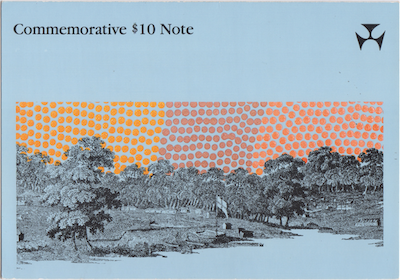
Interestingly, the 3 million notes that had actually been date stamped “26 JANUARY 1988” on the front and had AA serials were in fact not released in their light blue presentation folders until July 8th, 1988, well after the initial production problems had been resolved.
The Second Production Run
The Bicentennial $10 note was only released into circulation again after the printing process had been completely overhauled, on October 24th, 1988.
The prime difference between notes from the second production run, and those released from January 26th is in the varnish applied to the notes after they had been printed. Notes from the “AB First Series” have a thin and smooth varnish, whereas notes from the “AB Second Series” have a thick and mottled varnish. Notes with either 93, 94 or 96 as their 3rd and 4th digits in their serial numbers were excluded from the second production run.
A Successful Field Trial
Several intriguing comments regarding the 1988 $10 polymer note can be found in speeches made and research papers delivered by those involved with their production and distribution. One such comment was made by Mr John Taylor, Head of the Note Issue Department at the RBA, in a paper presented at the Currency Conference; October 1996: “In 1988, Australia conducted a field trial of polymer note technology to determine if the technology was viable. This trial involved putting into circulation, for a limited time, specially printed commemorative $10 notes. These notes replaced a significant number of the paper $10 notes that were in circulation. The $10 denomination was chosen because it was used heavily in day-to-day cash transactions.3”
This comment, along with others that have been published since then4, confirm rather clearly that not only was Australia's first polymer $10 note a commemorative for our Bicentennial year, it was just as importantly a field trial for the new polymer substrate and the OVD.
One can only presume that RBA staff deemed it prudent not to notify the general public of the field test – it would have been vital that the note be subjected to average and standard patterns of usage in circulation, and any forward notification of testing may well have distorted the results.
The feedback gained from the general public during the circulation trials was generally positive - cleanliness and durability were seen as the major advantages of the new notes, although concerns were repeatedly raised about the feel and handling of the banknotes.
Despite the technological appeal of the OVD and the significant capital that had been invested in designing it, the RBA chose to omit them from any future issues of polymer notes within Australia, removing the opportunity for deliberate tampering. Australia’s next series of banknotes were duly printed on polymer substrate, and were introduced denomination by denomination between 1992 and 1996.
As the first polymer banknote issued into circulation anywhere in the world, Australia's 1988 Bicentennial commemorative note is a pioneering innovation, and is certain to be keenly sought by currency collectors around the world for decades to come. The rarer and more historic varieties in superior condition have an additional element of rarity that sets them apart even further.
|
Reference Number |
Category |
Sub-Category |
Description |
|
Mc DS 29 |
Specimen |
Type Four |
Each note is over-stamped with the word SPECIMEN in subtle lettering; the serial numbers are all zeroes; each note is individually numbered. The exact number issued is not known, however is believed to be less than 50. |
|
Mc $10GF 4 |
Staff Presentation Folders |
- |
499 silver-covered folders were presented to NPA staff upon the issue of the Bicentennial commemorative. Such notes are identified by the serial prefix AA00, and have extremely low serial numbers. There are two notes in each folder. |
|
Mc $10GF 2 |
RBA Folders |
First Prefix |
800,000 single notes were placed in blue cardboard folders (that were in turn enclosed in white RBA envelopes) and distributed through Australia's major retail banks. Such notes are identified by the AA serial prefix. Notes with the AA 00 first prefix were the first printed. |
|
Mc $10GF 1 |
RBA Folders |
Standard Serials |
Standard serials are regarded as those that run between AA 01 and AA 22 |
|
Mc $10GF 3 |
RBA Folders |
Last Prefix |
Notes with the AA 23 prefix were the last printed |
|
R310aF Mc 173ai |
Circulation Issue - 1st Series |
First Prefix |
Notes printed during the first series have either 93, 94 or 96 as the 3rd and 4th digits. Notes with the AB 10 first prefix were the first printed. |
|
R310a Mc 173aii |
Circulation Issue - 1st Series |
Standard Serials |
Standard serials are regarded as those that run between AB 11 and AB 32. |
|
R310aL Mc 173aiii |
Circulation Issue - 1st Series |
Last Prefix |
Notes with the AB 33 prefix were the last printed. |
|
R310bF Mc 173b |
Circulation Issue - 2nd Series |
First Prefix |
None of the notes printed during the second series will have either 93, 94 or 96 as the 3rd and 4th digits. Notes with the AB 10 first prefix were the first printed. |
|
R310b Mc 173bi |
Circulation Issue - 2nd Series |
Standard Serials |
Standard serials are regarded as those that run between AB 11 and AB 56. |
|
R310bL Mc 173biii |
Circulation Issue - 2nd Series |
Last Prefix |
Notes with the AB 57 prefix were the last printed. |
1“Commemorative $10 note a hit”; Mick Vort-Ronald; Australian Coin Review, April 1988, p33
2ACR, December 1988, p23
3http://www.polymernotes.org/resources/taylor.htm
4http://www.polymernotes.org/resources/coventry6.htm
